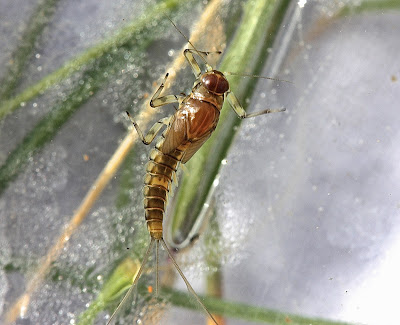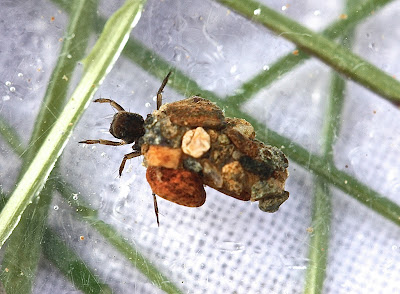Sunday, March 3, 2013
Nothing new at South River, but lots of things are maturing
Still cold and grey in Virginia. But we did have some sun this morning, so I headed up to South River. By the time I arrived, the clouds had moved in, and the temperature was a balmy 33 degrees!
But I was there -- so I was determined to take a look at the insects.
I didn't see anything new, anything I haven't been seeing in recent weeks, but a lot of insects have reached their pre-hatch lengths and colors.
1. Above -- a pronggilled mayfly, genus Paraleptophlebia. This measured 8 mm, and the "pronged" gills are very clear in that photo. Also note the length of the wing pads:
2. Small minnow mayfly, Baetis tricaudatus. Male, fairly mature. 6 -- 6.5 mm.
3. Spiny crawler mayfly, Ephemerella invaria. 8.5 mm.
Here's a nice view of the "intersegmental setae" on the tails (caudal filaments) -- one of the identifying features of the genus Ephemerella.
4. Green stonefly (Chloroperlidae), genus Sweltsa. Note how the wing pads are rounding out.
5. Perlodid stonefly, Isoperla namata. 7.5 mm. Note how the wing pads are moving away from the body.
6. And a Uenoid caddisfly larva, of course: Neophylax mitchelli. (Actually, this is the only one that I saw.)
If you enlarge these photos (click on them), the tubercle on the head is easy to see. I felt confident this was N. aniqua -- until I saw this microscope view.
Note the clavate gill on abdominal segment one: N. mitchelli has them, N. aniqua does not. And the tubercle turned out to be long, pointed, and pointing to the rear = N. mitchelli.
The most common taxa today -- Pronggilled mayflies, flatheaded mayflies -- Epeorus pleuralis, and the the Perodid stonefly Isoperla namata. I also saw quite a few Diploperla Perlodids and a few Clioperla clios. I would have liked to continue to look through the leaf packs -- but man that water was cold!
Subscribe to:
Post Comments (Atom)

















No comments:
Post a Comment